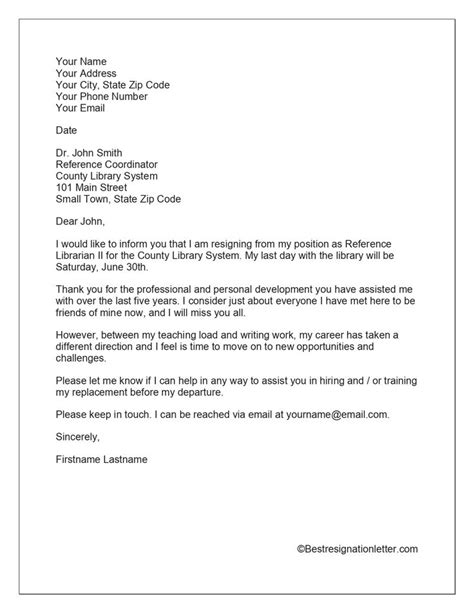Sample Resignation Letter: Explaining Your Departure

Resigning from a job can be a difficult decision that requires careful consideration. Whether you’re leaving for personal reasons, a better opportunity, or simply because you’re unhappy with your current situation, it’s important to handle your departure professionally and respectfully. One of the most important steps in this process is writing a resignation letter to inform your employer of your decision. In this article, we’ll provide a comprehensive guide on how to write a resignation letter that explains your departure in a clear and professional manner.
1. Start with a Professional Salutation
Begin your resignation letter with a professional salutation, addressing your employer by name. This can be “Dear [Employer’s Name],” or “To Whom It May Concern,” if you’re unsure who will be reading the letter. It’s important to maintain a respectful and professional tone throughout the letter, even if you’re leaving under less-than-ideal circumstances.
2. State Your Intention to Resign
The next step is to clearly state your intention to resign. Begin with a straightforward statement such as “I am writing to inform you that I am resigning from my position as [Job Title] effective [Date].” Be sure to give sufficient notice, as specified in your employment contract or company policy. In most cases, two weeks’ notice is standard, but you may need to provide more or less time depending on your situation.
3. Provide a Reason for Your Departure
While you’re not required to provide a reason for your departure, it can be helpful to do so in order to give your employer some context and closure. If you’re leaving for personal reasons, you can simply state that you’ve decided to pursue other opportunities or take a break from work. If you’re leaving for a new job, you can mention that you’ve accepted a position elsewhere. If you’re leaving due to issues with your current job or employer, it’s best to keep your explanation vague and professional.
4. Express Gratitude
Expressing gratitude is an important part of a resignation letter, as it shows that you appreciate the opportunities and experiences you’ve had while working for the company. Take the time to thank your employer for the skills and knowledge you’ve gained, as well as any mentorship or support they’ve provided during your time with the company.
5. Offer to Help with the Transition
Offering to help with the transition can be a helpful gesture that shows your employer that you’re committed to leaving on good terms. You can offer to assist with training your replacement, completing any outstanding projects, or providing any necessary information or documentation to ensure a smooth handover. Be sure to be specific about what you’re willing and able to do, as well as the timeframe in which you’ll be available to help.
6. Provide Contact Information
It’s important to provide your contact information in your resignation letter so that your employer can reach out to you if necessary. Be sure to include your personal email address and phone number, as well as any other relevant contact information.
7. Close with a Professional Sign-Off
Close your resignation letter with a professional sign-off, such as “Sincerely,” or “Best regards.” If you’re close with your employer, you can add a more personal touch, such as “Warmly,” or “With gratitude.” Sign your name at the bottom of the letter, using your full name and any relevant professional credentials or titles.
Conclusion
Writing a resignation letter can be a challenging task, but it’s an important part of leaving a job on good terms. By following these guidelines, you can create a professional and respectful letter that explains your departure in a clear and concise manner. Remember to maintain a positive and supportive tone throughout the letter, and to offer your assistance with the transition as much as possible.
FAQs
What should I include in my resignation letter?
Your resignation letter should include a professional salutation, a statement of your intention to resign, a reason for your departure (if desired), expressions of gratitude, an offer to help with the transition, your contact information, and a professional sign-off.
How much notice should I give when resigning?
The amount of notice you should give when resigning depends on your employment contract and company policy. In most cases, two weeks’ notice is standard, but you may need to provide more or less time depending on your situation.
Do I need to provide a reason for my departure?
You’re not required to provide a reason for your departure, but it can be helpful to do so in order to give your employer some context and closure. If you’re leaving for personal reasons, you can simply state that you’ve decided to pursue other opportunities or take a break from work. If you’re leaving for a new job, you can mention that you’ve accepted a position elsewhere. If you’re leaving due to issues with your current job or employer, it’s best to keep your explanation vague and professional.
Should I offer to help with the transition?
Offering to help with the transition can be a helpful gesture that shows your employer that you’re committed to leaving on good terms. You can offer to assist with training your replacement, completing any outstanding projects, or providing any necessary information or documentation to ensure a smooth handover.
How can I ensure a smooth transition when resigning?
To ensure a smooth transition when resigning, be sure to give sufficient notice, offer to help with the transition as much as possible, and maintain a positive and supportive tone throughout the process. Be sure to tie up any loose ends and complete any outstanding projects before your departure.
